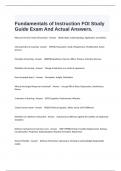Fundamentals of Instruction FOI Study
Guide Exam And Actual Answers.
What are the four levels of learning? - Answer (RUAC) Rote, Understanding, Application, Correlation
Characteristics of Learning - Answer (PEMA) Purposeful, result of Experience, Multifaceted, Active
process
Principles of learning - Answer (REEPIR) Readiness, Exercies, Effect, Primacy, Intensity, Recency
Definition of Learning - Answer Change in behavior as a result of experience
How do people learn? - Answer Perception, Insight, Motivation
Why do we forget things we've learned? - Answer (we get RID of them.) Repression, Interference,
Disuse
3 domains of learning - Answer (CPA) Cognitive, Psychomotor, Affective
5 basic human needs - Answer (PESSS) Physical, Egoistic, Safety, Social, Self Fulfillment
Definition of a defense mechanism - Answer Subconscious defenses against the realities of unpleasant
situations
Defense mechanisms 8 common ones - Answer (DDF CPRRR) Denial of reality, Displacement, Fantasy,
Compensation, Projection, Rationalization, Reaction formation, Repression
Denial of Reality - Answer Defense Mechanism: Ignoring or refusing to acknowledge disagreeable
reality
,Displacement - Answer Defense Mechanism: Shifting anxiety or anger from object to less threatening
substitute
Fantasy - Answer Defense Mechanism: Engaging in daydreams about the the way one would like things
to be
Compensation - Answer Defense mechanism: Emphasizing a positive trait to disguise the presence of a
weak or undesirable quality
Projection - Answer Defense Mechanism: Relegating blame for one's shortcomings to others.
Rationalization - Answer Defense Mechanism: Excuses
Reaction Formation - Answer Defense Mechanism: Faking opposite belief because reality causes
anxiety (e.g. "who cares" attitude to mask need for acceptance)
Repression - Answer Defense Mechanism: Placing uncomfortable thoughts into inaccessible places in
the unconscious mind
3 elements of communication - Answer Source, Symbols, Receiver
4 barriers to effective communication - Answer (CCIA) lack of Common experience, Confusion between
symbol and object symbolized, Interference, overuse of Abstractions
Steps for effective listening - Answer Take notes
Listen for main ideas
Don't daydream
Be emotionally calm
Listen to understand - not refute
Be responsible for listening
, Be ready to listen
Abnormal reactions to stress - Answer Extreme cooperation
inappropriate laughter or singing
rapid changes in emotions
severe anger
What is the single greatest barrier to effective communication - Answer Lack of a background of
common experience
What are the four basic steps in the teaching process? - Answer (Is my teaching on PPAR?)
Preparation
Presentation
Application
Review/Evaluation
CFI Preparation Stage Responsibilities - Answer Lesson plan that includes: Objectives, Procedures &
Facilities, Specific goals, Means for review and evaluation
Elements of performance based objectives - Answer Description of a skill or behavior, Conditions,
Criteria to measure success
3 main steps involved in organizing material for a particular lesson - Answer Introduction,
Development, Conclusion
Parts of an Introduction - Answer (start with AMO) Attention, Motivation, Overview
What are the five most common teaching methods? - Answer Lecture method
Guided discussion
Demonstration/Performance




